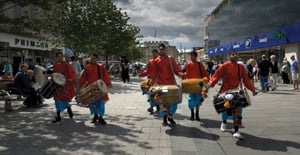Finders keepers?
Art Asia’s experience of the high-profile funding scheme Find Your Talent typifies the journey of many arts organisations as the recession begins to bite, writes Helen Keall


Find Your Talent (FYT) was a national government initiative launched in 2009 which aimed to give children and young people regular involvement with arts and culture. A three-year pilot was planned for 10 pathfinder areas across England, including an area designated as Urban South Hampshire which includes Southampton and Portsmouth. With nearly 30 years of experience working with Asian communities in the area, Art Asia was well placed to benefit from the scheme, which had generous funding levels attached – unlike so many initiatives which sound promising but turn out to be mainly marketing exercises with little or no cash for the actual delivery of work. We jumped at the opportunity to carry out some in-depth work with particular groups that we have found it hard to engage with – in particular young Asian males and members of the Bangladeshi community – and to test their interest in theatre.
FYT’s application structure helped us to develop well-targeted and successful projects. In common with many small arts organisations, it is difficult to find time to make speculative funding applications, which can involve a lot of planning and development work to engage project partners and potential participants, only to come to nothing if the application is not successful – an experience that is becoming increasingly common as competition for reduced funding sources increases. By contrast, entry to the FYT scheme was via a simple application form to secure a small amount of funding to run a short pilot project. Testing the water in this way helped us to go on to deliver strong projects that really engaged our target groups.
The FYT scheme also encouraged the inclusion of trips to other parts of the country to experience professional arts activity, and this proved to be a real incentive and inspiration to the young people. The three projects Art Asia ran during the first two years of FYT were:
• Bhangra Bonanza: Five musicians worked with 35 young Asian men from across the region to create a Dhol drumming group which went on to perform at the Royal Festival Hall
• The Bangla Project: 35 young Bangladeshis worked with a dancer and musician to learn folk songs in their mother tongue and traditional Bangla dance movements, which they performed in the Brick Lane Baishaki Mela Festival procession.
• South Asian Youth Theatre: Working in partnership with an inner-city Youth Centre and Asian theatre company Hathi Productions from Leicester, we ran a mix of workshops and one-off projects for young people in one the most deprived areas of Southampton.
Decent levels of funding and the three-year span of the scheme gave Art Asia the time and resources to begin to have a real impact on young people’s lives. A good example of this is Ricky Kasba, who first came to Art Asia when he attended the inaugural Bhangra Bonanza workshop. Ricky had been playing for many years and his talent and commitment were clear, but had no focus. With the support of Art Asia’s Education Development Officer and opportunities to shadow professional Dhol performers and tutors throughout the Bhangra Bonanza project, Ricky is now starting to earn a living from his talent, including teaching Dhol drumming. A regular programme of Dhol classes and an active performance group is just one of the ways in which Art Asia had planned to continue the work started with FYT funding. Unfortunately, we were hit by the succession of cuts that have had an impact across the whole sector, and the other two projects have not had such successful outcomes.
Firstly, the FYT scheme was abruptly wound up a year early, meaning that the Bangla project, which was the last to start, ran out of funds before the work was properly embedded. Without resources, it has not been possible to maintain the work that started so promisingly. Secondly, local authority cuts meant that key personnel from the Youth Centre were redeployed elsewhere and opening hours severely reduced, and it has proved a real challenge to keep the young people engaged in the South Asian Theatre Group. Thirdly, a 63% cut to Art Asia’s ACE revenue grant from 2012/13 meant that we will have to focus on developing the income-generating aspects of our work, leaving little time or money to continue the resource-hungry but very rewarding work of reaching out to the groups on the margins of our community. Before the full impact of our grant cut hits, we are working hard to find alternative sources to continue this work, but in common with so many others we are facing the frustration of seeing the fruits of years of hard work and inspiration wither on the vine.
Join the Discussion
You must be logged in to post a comment.